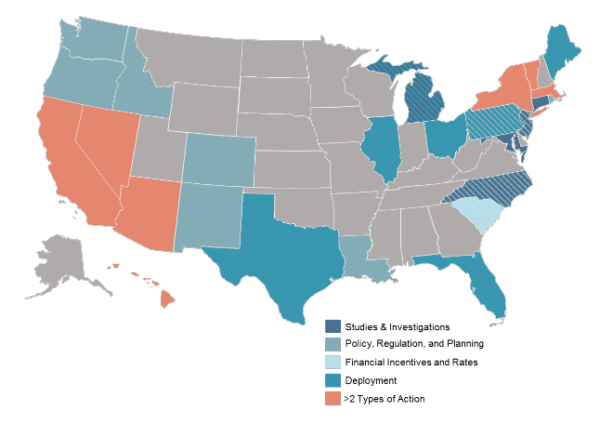While the overall volume of energy storage deployments in the United States remains relatively modest, the technology is gaining more and more traction with utilities and policymakers, as evidenced in North Carolina Clean Energy Technology Center’s (NCCETC) latest 50 States of Grid Modernization report.
NCCETC found that among the 33 states that took legislative or regulatory action on grid modernization in Q3, 26 took some sort of action on energy storage. This includes not only the usual suspects of California, and the Northeastern states, but also an increasingly broad group of states in the South, the Mountain West and the Midwest.

In fact, among the top policy actions identified by NCCETC during the quarter is a move by regulators in both Washington State and New Mexico to require utilities to fully evaluate energy storage alongside other options in their integrated resource plans.
In many cases regulators are simply calling for utilities to deploy energy storage, and NCCETC found 14 policy actions related to storage deployment during Q3.
Utilities discover batteries
But far from having storage forced upon them, many utilities are seeking to deploy batteries and other forms of energy storage. During Q3, an administrative law judge in Texas has recommended that AEP be allowed to own battery storage, after the utility proposed deploying two battery storage systems to defer transmission and distribution investments.
NCCETC says that this trend goes beyond batteries. “Distributed energy resources are being increasingly viewed as a potential solution, rather than simply a challenge,” states Autumn Proudlove, the report’s author and manager of policy research at NCCETC.
A similar conclusion was reached by Smart Electric Power Association, which reported in September that the majority of utilities it surveyed planned to offer behind-the-meter storage programs for residential and/or commercial and industrial customers.
If anything, there appears to be a virtuous cycle between regulatory action and voluntary utility deployment of storage, with utility Portland General Electric announcing on its Q3 earnings call that it would deploy seven times the capacity of energy storage mandated by the state.
Going deep on grid modernization
The report was hardly limited to energy storage, and found that the deployment of advanced meters and smart grid features was even more common than energy storage deployment during Q3.
An increasing number of states are also looking beyond piecemeal approaches to grid modernization, and instead tackling broader issues, including the utility business model. Following the high-profile Reforming the Energy Vision (REV) process in New York, Vermont and Rhode Island also launched broad grid modernization proceedings.
As the latest during Q3 Oregon passed a bill into law that will require state regulators to investigate the changing grid landscape including new technologies, policy drivers and utility incentives.
“The level of activity we’ve seen around the country in recent months shows a significant and sustained interest in modernizing the grid all across the country,” noted Brian Lips, senior project manager at NCCETC.
The Q3 report is the third quarterly edition of the 50 States of Grid Modernization report, which was launched in April of this year.
This content is protected by copyright and may not be reused. If you want to cooperate with us and would like to reuse some of our content, please contact: editors@pv-magazine.com.









By submitting this form you agree to pv magazine using your data for the purposes of publishing your comment.
Your personal data will only be disclosed or otherwise transmitted to third parties for the purposes of spam filtering or if this is necessary for technical maintenance of the website. Any other transfer to third parties will not take place unless this is justified on the basis of applicable data protection regulations or if pv magazine is legally obliged to do so.
You may revoke this consent at any time with effect for the future, in which case your personal data will be deleted immediately. Otherwise, your data will be deleted if pv magazine has processed your request or the purpose of data storage is fulfilled.
Further information on data privacy can be found in our Data Protection Policy.